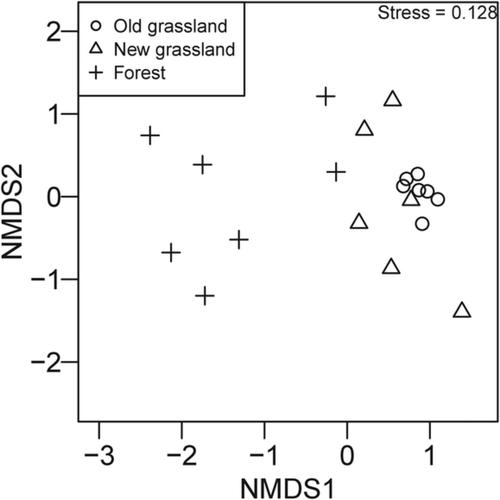当前位置:
X-MOL 学术
›
Ecol. Res.
›
论文详情
Our official English website, www.x-mol.net, welcomes your
feedback! (Note: you will need to create a separate account there.)
The effects of temporal continuities of grasslands on the diversity and species composition of plants
Ecological Research ( IF 1.7 ) Pub Date : 2020-09-01 , DOI: 10.1111/1440-1703.12169 Taiki Inoue 1 , Yuki A. Yaida 2 , Yuki Uehara 2 , Koki R. Katsuhara 2 , Jun Kawai 1 , Keiko Takashima 2 , Atushi Ushimaru 2 , Tanaka Kenta 1
Ecological Research ( IF 1.7 ) Pub Date : 2020-09-01 , DOI: 10.1111/1440-1703.12169 Taiki Inoue 1 , Yuki A. Yaida 2 , Yuki Uehara 2 , Koki R. Katsuhara 2 , Jun Kawai 1 , Keiko Takashima 2 , Atushi Ushimaru 2 , Tanaka Kenta 1
Affiliation

|
Seminatural grasslands are ecosystems rich in biodiversity. However, their decline has been reported worldwide, and identification of grasslands with high conservation priority is urgently required. Recently, an increasing number of studies have reported that past vegetation history affects current biological communities. To evaluate whether the temporal continuity of grasslands promotes biodiversity, and thus can be an indicator of conservation priority, we studied vascular plant communities in old (160–1000s years) and new (52–70 years after deforestation) grasslands, as well as in forests, of Sugadaira Highland in central Japan. The number of plant species was highest in old grasslands, followed by new grasslands and forests. This pattern was much clearer in the number of grassland‐dependent native and grassland‐dependent endangered species, indicating the role of old grasslands as refugia for those species. The species composition differed between old and new grasslands. New grasslands had species compositions in between those of old grasslands and forests, suggesting that the plant community in new grasslands retains the influence of past forestation for more than 52 years after deforestation. Eleven indicator species were detected in old grasslands, but none in new grasslands, suggesting the uniqueness of the plant community in old grasslands. We conclude that the temporal continuity of grasslands increases plant diversity and can be an indicator of grasslands with high conservation priority.
中文翻译:

草地时间连续性对植物多样性和物种组成的影响
半天然草原是生物多样性丰富的生态系统。然而,全世界范围内它们的减少都有报道,迫切需要确定具有高度保护优先性的草原。最近,越来越多的研究报告说过去的植被历史影响了当前的生物群落。为了评估草原的时间连续性是否促进了生物多样性,从而可以作为优先保护的指标,我们研究了旧(160-1000s年)和新(毁林后52-70年)草原和新草原的维管植物群落。森林,在日本中部的杉田平高原。植物种类的数量在老草原最高,其次是新草原和森林。这种模式在依赖草原的本地和濒临灭绝的濒危物种的数量上更为清晰,表明了旧草原作为这些物种的避难所的作用。新旧草地的物种组成有所不同。新草原的物种组成介于旧草原和森林之间,这表明新草原上的植物群落在毁林后的52年内都保留了过去造林的影响。在旧草原中发现了11种指示剂物种,而在新草原中没有发现,这表明旧草原中植物群落的独特性。我们得出结论,草原的时间连续性增加了植物的多样性,可以作为具有高度保护优先性的草原的指标。新草原的物种组成介于旧草原和森林之间,这表明新草原上的植物群落在毁林后的52年内都保留了过去造林的影响。在旧草原中发现了11种指示剂物种,而在新草原中没有发现,这表明旧草原中植物群落的独特性。我们得出结论,草原的时间连续性增加了植物的多样性,可以作为具有高度保护优先性的草原的指标。新草原的物种组成介于旧草原和森林之间,这表明新草原上的植物群落在毁林后的52年中都保留了过去造林的影响。在旧草原中发现了11种指示剂物种,而在新草原中没有发现,这表明旧草原中植物群落的独特性。我们得出结论,草原的时间连续性增加了植物的多样性,可以作为具有高度保护优先性的草原的指标。
更新日期:2020-09-01
中文翻译:

草地时间连续性对植物多样性和物种组成的影响
半天然草原是生物多样性丰富的生态系统。然而,全世界范围内它们的减少都有报道,迫切需要确定具有高度保护优先性的草原。最近,越来越多的研究报告说过去的植被历史影响了当前的生物群落。为了评估草原的时间连续性是否促进了生物多样性,从而可以作为优先保护的指标,我们研究了旧(160-1000s年)和新(毁林后52-70年)草原和新草原的维管植物群落。森林,在日本中部的杉田平高原。植物种类的数量在老草原最高,其次是新草原和森林。这种模式在依赖草原的本地和濒临灭绝的濒危物种的数量上更为清晰,表明了旧草原作为这些物种的避难所的作用。新旧草地的物种组成有所不同。新草原的物种组成介于旧草原和森林之间,这表明新草原上的植物群落在毁林后的52年内都保留了过去造林的影响。在旧草原中发现了11种指示剂物种,而在新草原中没有发现,这表明旧草原中植物群落的独特性。我们得出结论,草原的时间连续性增加了植物的多样性,可以作为具有高度保护优先性的草原的指标。新草原的物种组成介于旧草原和森林之间,这表明新草原上的植物群落在毁林后的52年内都保留了过去造林的影响。在旧草原中发现了11种指示剂物种,而在新草原中没有发现,这表明旧草原中植物群落的独特性。我们得出结论,草原的时间连续性增加了植物的多样性,可以作为具有高度保护优先性的草原的指标。新草原的物种组成介于旧草原和森林之间,这表明新草原上的植物群落在毁林后的52年中都保留了过去造林的影响。在旧草原中发现了11种指示剂物种,而在新草原中没有发现,这表明旧草原中植物群落的独特性。我们得出结论,草原的时间连续性增加了植物的多样性,可以作为具有高度保护优先性的草原的指标。











































 京公网安备 11010802027423号
京公网安备 11010802027423号